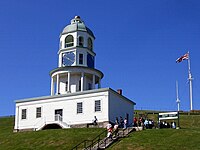Mic-Mac hockey stick

The Mic-Mac hockey stick was made originally by the Mi'kmaq people of Nova Scotia, who dominated the international ice hockey market in the early twentieth century. It was first marketed by the Starr Manufacturing Company of Dartmouth, Nova Scotia, in the 1860s.
The Mi'kmaq practice of playing hockey appears in recorded colonial histories beginning in the 18th century, and beginning in the 19th century they were credited with inventing the ice hockey stick.[1] The oldest known hockey stick, now owned by the Canadian Museum of History, dates to the mid-1830s and is made of sugar maple wood; it may have been made by a Mi'kmaq.[2][3] (In 2006, a stick made by Mi'kmaq in the 1850s, at the time the oldest known, was sold at auction for $2.2 million; it had been appraised at US$4.25 million.[4]


| History of Halifax, Nova Scotia |
|---|
 |
In 1863, the Starr Manufacturing Company in Dartmouth, Nova Scotia, began to sell the Mic-Mac Hockey Stick nationally and internationally.[6] Hockey became a popular sport in Canada in the 1890s,[7] and through the first decade of the 20th century, the Mic-Mac was the best-selling hockey stick in Canada. By 1903, apart from farming, producing them was the primary occupation of the Mi'kmaq on reserves throughout Nova Scotia, particularly Shubenacadie, Indian Brook and Millbrook.[6] In 1927 the department of Indian Affairs for Nova Scotia noted that the Mi'kmaq remained the "experts" at making hockey sticks.[8] Mi'kmaq continued to make hockey sticks until the 1930s, when the product was industrialized.[9][10]
References[edit]
- ^ Cuthbertson, Brian (2005). "The Starr Manufacturing Company: Skate Exporter to the World". Journal of the Royal Nova Scotia Historical Society. 8: 60.
- ^ Adams, James (January 9, 2015). "World's oldest known hockey stick tells a very Canadian tale". The Globe and Mail. Toronto.
- ^ "Canadian Museum of History acquires world's oldest hockey stick: History museum pays $300K to Nova Scotia man for hockey stick". CBC. The Canadian Press. January 9, 2015.
- ^ "Hockey stick billed as oldest ever nets $2.2 million". The Globe and Mail (revised April 7, 2009). The Canadian Press. December 22, 2006.
- ^ Cuthbertson, p. 61. Note that Cuthbertson erroneously states the photo was taken in 1888, rather than 1889.
- ^ a b Cuthbertson, p. 61. The date 1863 presumes that the company started to sell hockey sticks the same year they began selling hockey skates.
- ^ Cuthbertson, p. 58.
- ^ Cuthbertson, p. 73.
- ^ Cuthbertson, p. 63.
- ^ Smith, Emma (December 13, 2014). "Stickhandling: First Nations played big role in carving out hockey history". The Chronicle Herald. Halifax, Nova Scotia.
